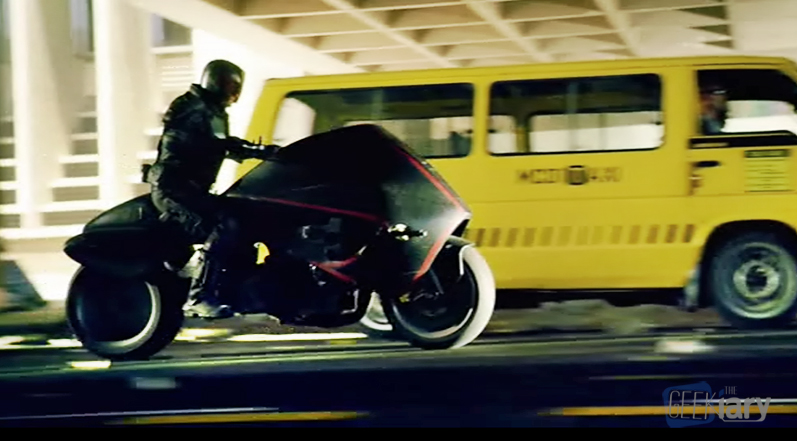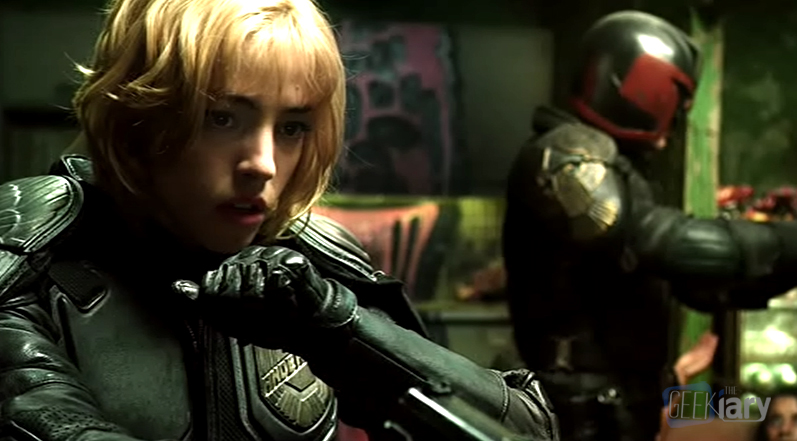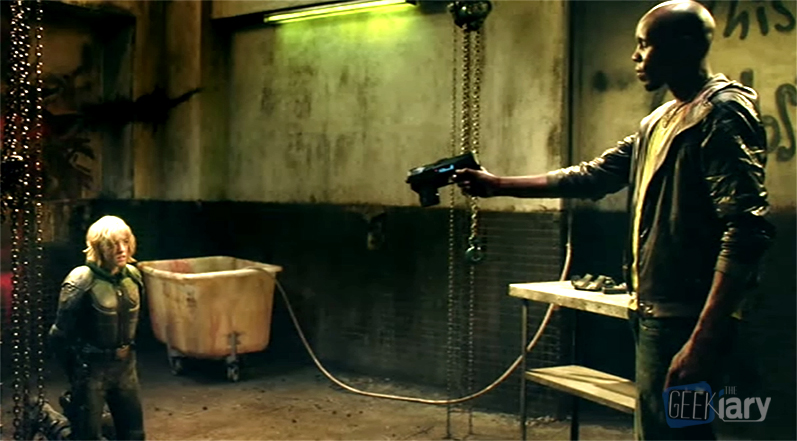Dredd: How to take every bad action movie cliché and not use a single one.
 The new Dredd movie has been around since the September of 2012, but it was only a few days ago when I decided to watch it. The trailer simply didn’t motivate me the first time I saw it – maybe because I have never read the comics, or maybe because I was not particularly fond of the first Dredd. Of course I was planning to familiarize myself with it, but I expected it to be nothing more but a classical action movie. You know the one: shooting, chasing, explosions… The kind of entertainment massively produced in special movie factories of mass production for the masses, created by reusing the same exact plot lines with the character names, costumes, and backgrounds switched out. I’m not trying to say that those types of movies are bad. They can still be fun to watch when you have some free time and nothing better to do, as long as your expectations are for a way to waste time instead of a piece of art.
The new Dredd movie has been around since the September of 2012, but it was only a few days ago when I decided to watch it. The trailer simply didn’t motivate me the first time I saw it – maybe because I have never read the comics, or maybe because I was not particularly fond of the first Dredd. Of course I was planning to familiarize myself with it, but I expected it to be nothing more but a classical action movie. You know the one: shooting, chasing, explosions… The kind of entertainment massively produced in special movie factories of mass production for the masses, created by reusing the same exact plot lines with the character names, costumes, and backgrounds switched out. I’m not trying to say that those types of movies are bad. They can still be fun to watch when you have some free time and nothing better to do, as long as your expectations are for a way to waste time instead of a piece of art.
That was the precise reason why I missed Dredd when it first came out, and I really need to say that I was wrong. This movie has not only exceeded all of my expectations, but unexpectedly moved to the list of my favorite movies ever. And the reason for it was the fact that no matter how many setups for bad clichés they created, they managed to not use a single one.
The first thing I would like to talk about is the general plot. How often does it happen that an action movie plot is so complicated that it sometimes becomes difficult to follow? Of course there are plenty of examples where the complexity works well, especially if you prefer to concentrate on the visual aspects of the movie, but even then it has a tendency to generate many holes.
Dredd decided to take a completely different road by introducing us to a plot so simple that at first it was difficult to believe it would be able to carry a feature-length film. The premise is this: two judges trapped in a giant building run by drug dealers. That’s it! But it was written so well that it was easy to forget that the entire action of the movie was taking place in one location. Instead of complicated side plots built one on top of another, the creators of the movie decided to concentrate on one thing, allowing them to create a very detailed background and atmosphere.

The movie starts with a general introduction to the world. We learn about the judges: a special order of people given the power of judge, jury and executioner. The judges operate in Mega-City One, a metropolis lying in a post-apocalyptic wasteland. We are also made aware of the existence of a narcotic substance called slo-mo, which as the name suggests, slows down the user’s perception of reality. And of course, we are introduced to Dredd (Karl Urban) himself, who first appears chasing some nameless criminals on his fancy bike, plated in armor and wearing his trademark helmet.
Speaking of the helmet, there goes another expectation out the window: it never comes off, and so we never get to see Dredd’s face. Even though this is faithful to the comics, it’s surprising for a movie adaptation. In movies, whether to satisfy the audience’s curiosity at the expense of the story or because leading actors tend to want their face on the screen, masked characters very rarely remain masked forever. The decision to leave Dredd faceless increased my respect for Karl Urban and lent a lot of credibility to the movie.
After Dredd’s opening chase scene, we are introduced to yet another character – a young recruit named Cassandra Anderson (Olivia Thirlby). Cassandra failed the aptitude test to be a Judge, but was given a second chance because of her special psychic abilities. She is assigned to Dredd for evaluation in the field.
In other words, she’s his sidekick.
Don’t get me wrong, this sort of cliché can be great if well-executed (just look at Doctor Who). A well-written sidekick is an opportunity to not only shape the success of the adventure, but also foil to highlight the main character and drive their development. But there are plenty of examples where a sidekick is thrown into a script for no real narrative reason, and are so underused or painfully shoehorned in that they make you wish the entire concept of sidekicks would cease to exist. I don’t have to go far for an example – the first Judge Dredd movie contained Herman Ferguson, an annoying comic-relief-type sidekick who was not only useless but absolutely unfunny. When sidekicks are bad, they’re bad.
But Cassandra is one of the good ones. She’s on such equal footing with Dredd narrative-wise that sometimes I had to remind myself which of them was the main character and which was the sidekick by taking a look at the DVD cover.
So they pulled off a good sidekick, but what about a love interest? Practically every action movie has one, crammed into the short run-time. As a result not only the romance feels flat, but it also draws the attention away from the main plot. Not to mention the heteronormative idea that any two people of the opposite sex, who spend the course of a movie together must be sexually attracted.
But in Dredd, the romance never materializes. In fact, Dredd and Cassandra haven’t even become friends by the end of the movie. They simply haven’t had enough time. The plot moves them forward quickly enough that getting to know each other more closely than in a professional capacity just doesn’t make sense. And their chemistry based on their relationship as a judge and a rookie was done well enough for it to be absolutely satisfying, no romance subplot needed.
But even though it dodges the bullet of poorly-written romance, no action movie, not even Dredd, can avoid the cliche of the “damsel in distress.” About midway through the movie, Cassandra gets kidnapped.

And it is so common for a male protagonist to have rescue a captured woman, that we don’t even notice it anymore. It is one thing when the woman is portrayed as a simple civilian, but it is annoying to see a character previously shown as someone strong and capable on par with the protagonist getting a sudden downgrade. This is what I feared could happen to Cassandra, but yet again I was pleasantly surprised, as the typical damsel in distress scenario was used to create one of the most badass moments in the entire movie, where not only Cassandra gets free without any help, but also saves Dredd himself later.
Finally, the two heroes go to the main confrontation with the leader of the drug dealing thug group, Ma-ma (Lena Headey). This is a perfect setting for another cliché – the “final battle.” This is the part of the movie where you’d usually get ready to endure a drawn-out, predictable showdown, probably with at least one moment where you’re supposed to think the hero has lost (he hasn’t). In confrontations like this, there is very little that can surprise a jaded audience.
But right when you’re settling in for the inevitable slugfest, Dredd shoots Ma-ma and throws her from the top floor of the building, handily ending the fight and leaving the audience stunned to say the least. Granted, this resolution for an action scene has been used many times before (remember the famous moment from the Indiana Jones movie where he shoots the guy with the swords?), but most of the time it’s meant as a comic moment and not a means to defeat the main baddie.

And so the block is successfully cleared of the thugs, rookie Cassandra proves herself to be ready to become a real judge, and a few corrupted judges are brought to justice in the process, leaving me absolutely satisfied with the experience. It was fresh, it was unexpected, it was well-written and well-played. Yes, I honestly can count the movies I would give the highest rating on my fingers, but this one proudly found its place in the list. So, if you, like me, made the mistake of deciding to skip watching Dredd because you didn’t expect much, I sincerely advise you to fix it.
Directed by: Pete Travis;
Produced by: Alex Garland, Andrew MacDonald, Allon Reich
Written by: Alex Garland;
Studio: DNA Films, IM Global, Reliance Entertainment;
Release date(s): 11 July 2012 (San-Diego Comic Con), 7 September 2012 (United Kingdom);
Running time: 95 minutes.
Author: Rinienne
Rin created our website logo and many other graphics that we’ve used throughout our social media platforms. They’re also an avid gamer and gives us insights into all things gaming. They’re also heavily involved in our ongoing eBook project.
Help support independent journalism. Subscribe to our Patreon.
Copyright © The Geekiary
Do not copy our content in whole to other websites. If you are reading this anywhere besides TheGeekiary.com, it has been stolen.Read our


I saw it last night and liked it. It was better than the original.
I think it was worth watching the movie,, too.